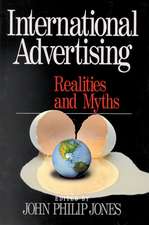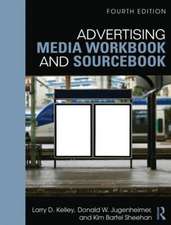Advertising: A Cultural Economy: Culture, Representation and Identity series
Autor Liz McFallen Limba Engleză Paperback – 17 feb 2004
Advertising: A Cultural Economy uses a historical study of advertising to regain a sense of how it has been patterned, not by the `epoch', but by the interaction of institutional, organisational and technological forces.
| Toate formatele și edițiile | Preț | Express |
|---|---|---|
| Paperback (1) | 429.11 lei 6-8 săpt. | |
| SAGE Publications – 17 feb 2004 | 429.11 lei 6-8 săpt. | |
| Hardback (1) | 1219.06 lei 6-8 săpt. | |
| SAGE Publications – 17 feb 2004 | 1219.06 lei 6-8 săpt. |
Preț: 429.11 lei
Preț vechi: 504.84 lei
-15% Nou
Puncte Express: 644
Preț estimativ în valută:
82.11€ • 86.04$ • 67.88£
82.11€ • 86.04$ • 67.88£
Carte tipărită la comandă
Livrare economică 11-25 aprilie
Preluare comenzi: 021 569.72.76
Specificații
ISBN-13: 9780761942559
ISBN-10: 0761942556
Pagini: 224
Dimensiuni: 156 x 234 x 13 mm
Greutate: 0.35 kg
Ediția:First Edition
Editura: SAGE Publications
Colecția Sage Publications Ltd
Seria Culture, Representation and Identity series
Locul publicării:London, United Kingdom
ISBN-10: 0761942556
Pagini: 224
Dimensiuni: 156 x 234 x 13 mm
Greutate: 0.35 kg
Ediția:First Edition
Editura: SAGE Publications
Colecția Sage Publications Ltd
Seria Culture, Representation and Identity series
Locul publicării:London, United Kingdom
Cuprins
Introduction
The Quaint Device of Advertising
Colonising of the Real
The Persuasive Subject of Advertising
The Hybridisation of Culture and Economy
The Uses of History
Pervasive Institutions and Constituent Practices
Persuasive Products
Conclusion
Devices and Desires
The Quaint Device of Advertising
Colonising of the Real
The Persuasive Subject of Advertising
The Hybridisation of Culture and Economy
The Uses of History
Pervasive Institutions and Constituent Practices
Persuasive Products
Conclusion
Devices and Desires
Descriere
Advertising is often used to illustrate popular and academic debates about cultural and economic life. This book reviews cultural and sociological approaches to advertising and, using historical evidence, demonstrates that a rethink of the analysis of advertising is long overdue.
















